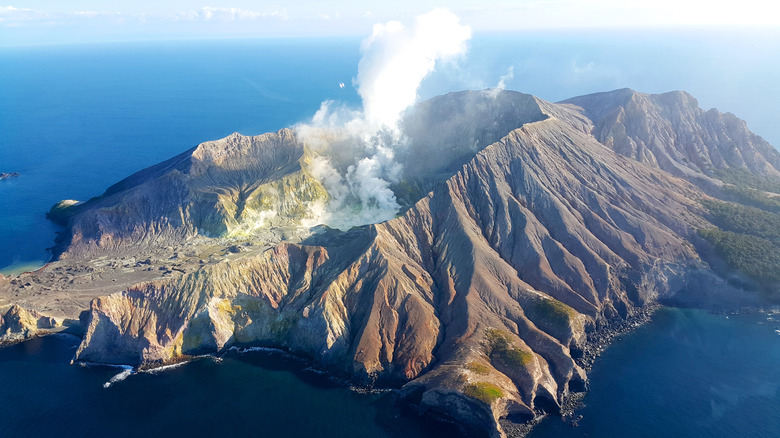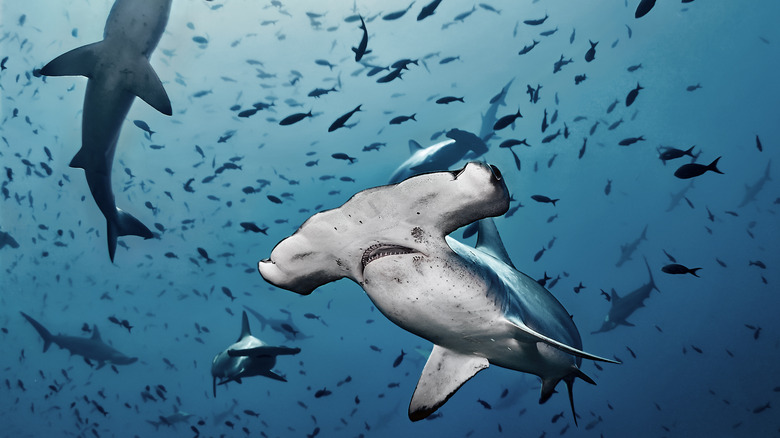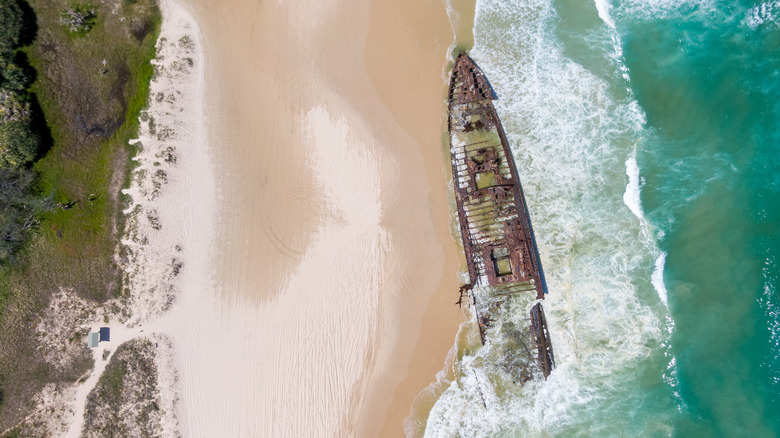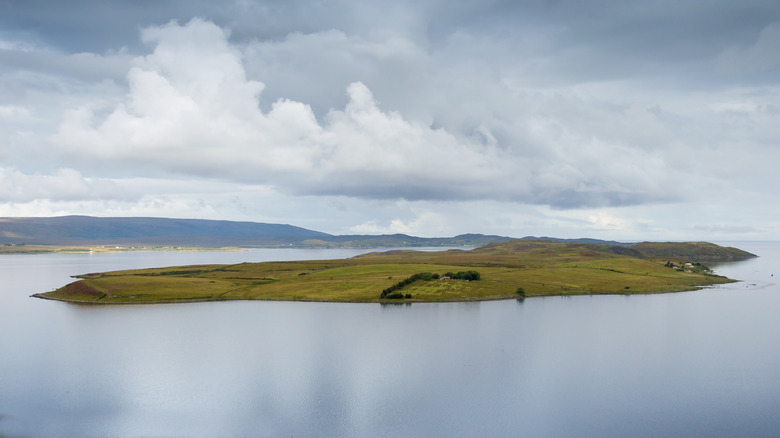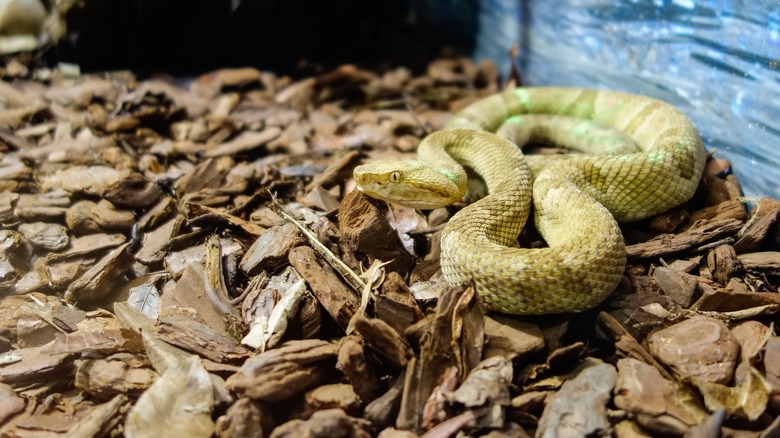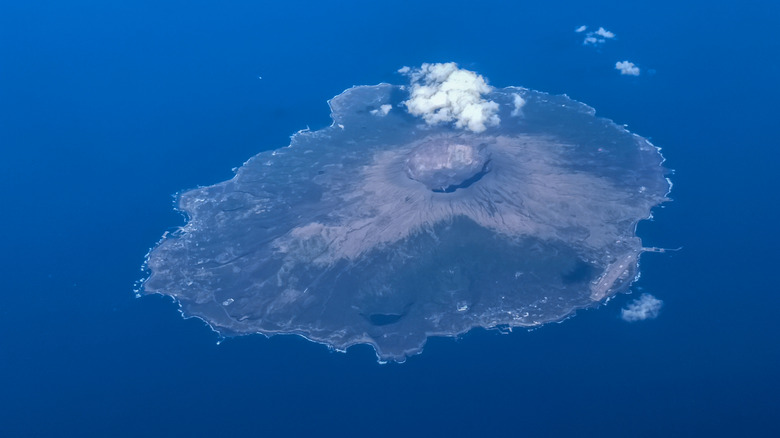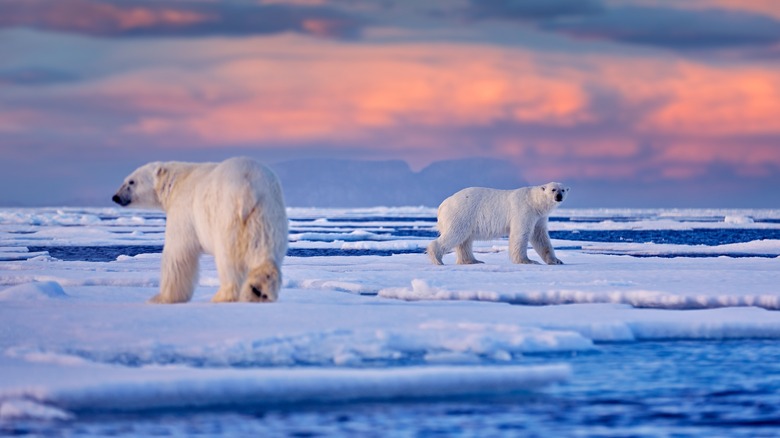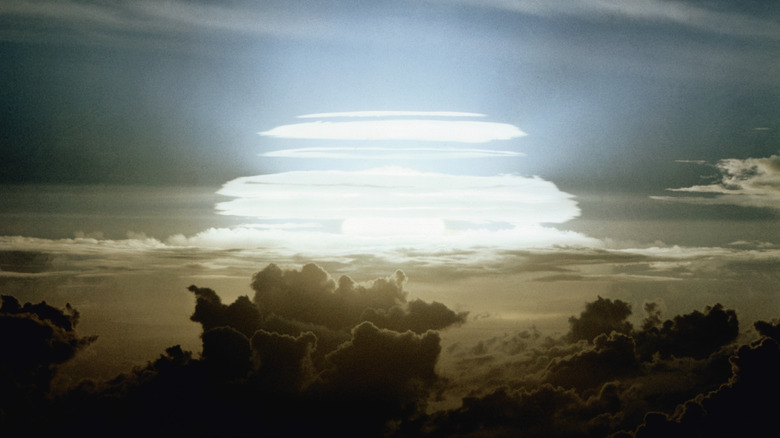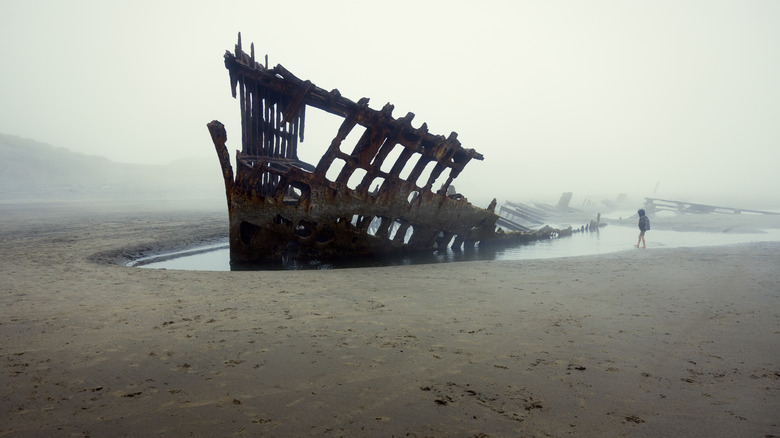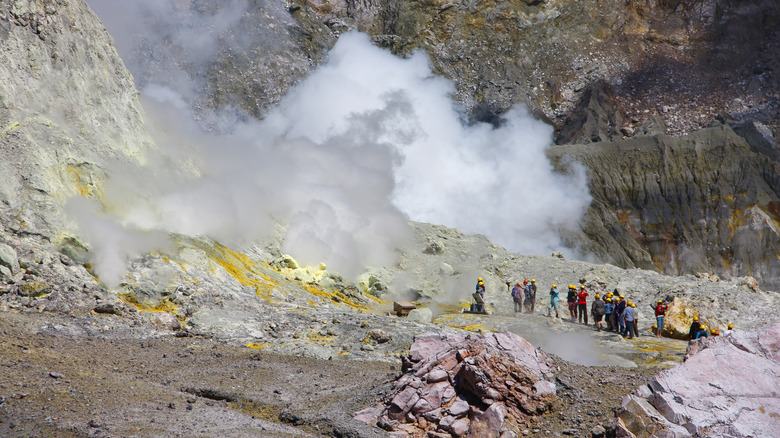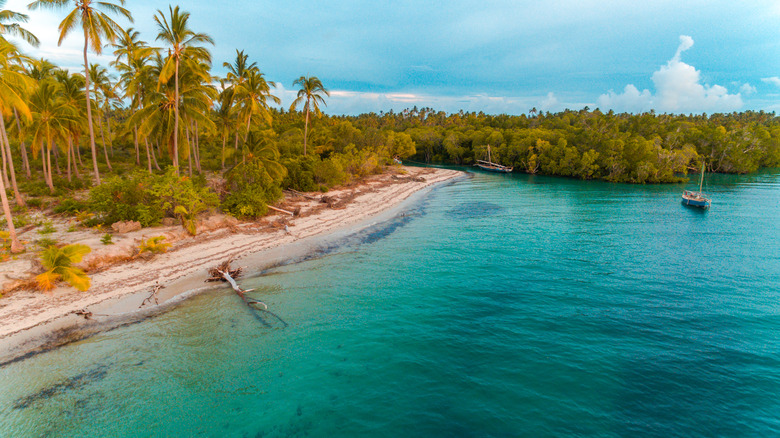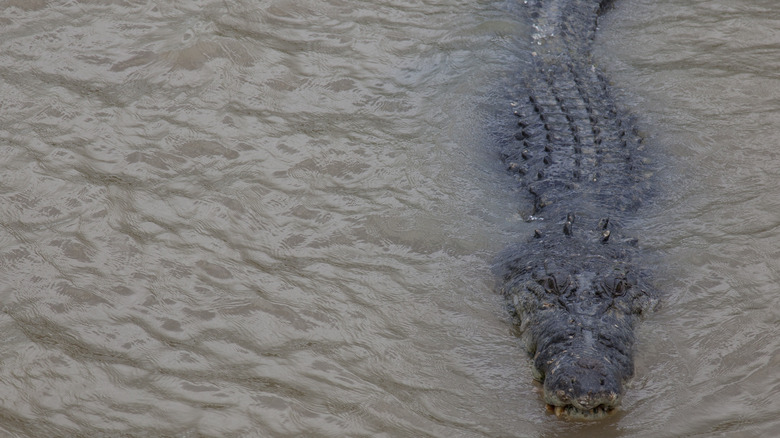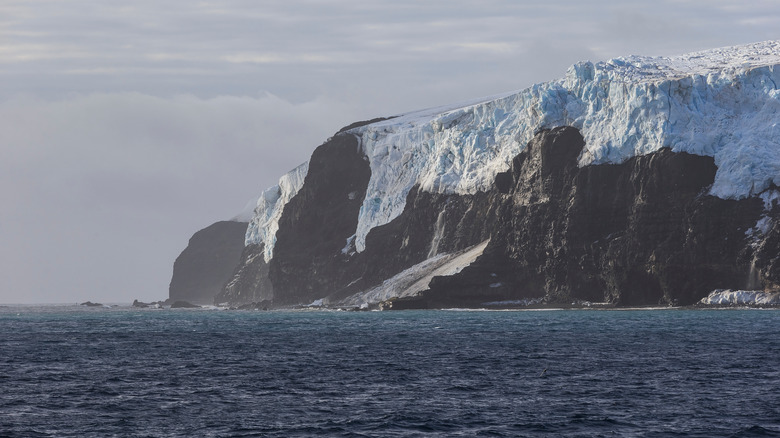Islands Around The World That Are The Most Dangerous
Visiting an island usually means days of splaying out on the beach, fruity cocktails, and a boost of relaxation. Travelers crave the island vacation experience at spots like Florida's Wekiva Island for an indulgent break away from all the everyday stressors of life. However, with thousands of islands around the globe, from Sweden to Vietnam, not every single one is going to be paradise. These floating land masses can actually be some of the most dangerous places on the planet for a variety of reasons.
When stuck on a tiny sliver of land all the way out in the middle of the ocean, you can encounter many dangers. Some islands have aggressive beasts hiding in the shadows and waiting to tear any visitor limb from limb the second they arrive. Radioactive waste fills other islands after serving as the site of nuclear testing experiments for years. Certain islands have grown infamous for causing deadly shipwrecks, while unpredictable volcanoes that have claimed the lives of travelers plague others. Carefully weigh these factors before taking a boat to the world's most dangerous islands.
Cocos Island, Costa Rica
At first glance, Cocos Island may seem like an ideal destination for a budget-friendly Costa Rica visit with less crowds. However, it isn't nearly as harmless as it sounds. Cocos Island may have served as the real-life inspiration for the "Jurassic Park" movie, partly because of the large number of critters on (and around) the island. Cocos Island is crawling and swimming with animals that can be terrifying or even deadly to humans. To start, 362 species of rare insects live in the island's rainforest. These creepy crawlies will probably send a chill up your spine and can potentially spread disease, but the real danger around Cocos Island lurks in the ocean.
The waters around the island have long been a popular diving spot, though visitors have had some unwelcome brushes with the hordes of hammerhead and tiger sharks that patrol the coastline around Cocos. These species are known for being defensive, and you can easily attract these sharks while swimming or snorkeling in the water around Cocos Island. In 2018, a female tiger shark killed Rohina Bhandari, a 49-year-old woman diving in the area. Though the sharks around Cocos Island present some danger to divers, Florida Museum's International Shark Attack File reports that unprovoked shark attacks remain incredibly rare, with only eight of these incidents confirmed in Costa Rica since 1907.
Fraser Island, Australia
The UNESCO World Heritage Site of Fraser Island is the largest sand island in the world, with over 155 miles of beaches. With all that wide-open space, it sounds idyllic and like it could be one of the best islands to visit on vacation. However, some serious dangers come with heading to this Australian locale. Despite the tempting stretches of sand, the waters around Fraser are some of the worst places to swim on the globe. No lifeguards patrol the miles of beach, and it is a very risky place to take a dip, even for experienced swimmers. The area gets strong riptides, plus sharks and jellyfish are common. There are potential threats to worry about on dry land as well.
Visitors are pretty much guaranteed to come face-to-face with an animal anywhere in Australia, but that creature may not be so friendly if it lives on Fraser Island. It has a large population of dingoes that roam the area. They are fun to watch from a distance and usually steer clear of humans out of fear. However, they are still wild animals and have been known to get aggressive out of nowhere. In February 2024, a little boy was rushed to the hospital after being attacked by a dingo on Fraser Island. Just a few weeks later, dingoes bit two more women visiting the island. The dingoes of Fraser Island have become more vicious in recent years, making the area an even more dangerous place to visit.
Gruinard Island, Scotland
Any place called "Anthrax Island" should immediately send up some red flags as a dangerous destination. That is the terrifying nickname for Gruinard Island in Scotland. It picked up the moniker after World War II when the United Kingdom used Gruinard Island to carry out germ warfare experiments. Anthrax, an extremely deadly illness that comes from bacteria, can cause blisters, chest pain, vomiting blood, and eventually death. The U.K. government brought animals to live on the island and then infected the whole place with this nasty stuff. It didn't take long for the disturbing effects to occur, and soon, all the livestock died or headed towards death.
These experiments didn't just hurt the animals; they also made all of Gruinard Island toxic to any living thing because of the anthrax soaked into the soil. "Hereabouts, they call it the island of death, the mystery Island, and for good reason," described a BBC reporter. It became so contaminated that people couldn't step foot on the island for nearly 50 years until 1990 when the Ministry of Defense declared the soil free from the presence of anthrax. While people can technically visit Anthrax Island these days, there isn't much to see, and some experts reportedly believe that the area will remain infected with anthrax for another few hundred years. In 2022, a massive fire, described by locals as "apocalyptic," swept over the island.
Ilha da Queimada Grande, Brazil
Few situations sound more terrifying than getting stuck on an island completely overrun with venomous snakes that can kill you with a single bite. Imagine if you couldn't take a single step without getting near another one of these deadly reptiles. Visitors face this exact nightmarish scenario on Ilha da Queimada Grande off the coast of Brazil.
On this stretch of land in the Atlantic Ocean, approximately 4,000 golden lancehead snakes slither through the forests. This island reportedly houses about one snake for every square meter (via Smithsonian Magazine), and these aren't the harmless, everyday garden variety. The things they can do to the human body are horrifying.
Due to its isolation on a tiny island, the venom of this species of viper evolved in a curious way, making it up to five times stronger than most snakes on the mainland. The powerful venom of a golden lancehead has been known to melt human flesh and can kill a person in less than an hour. The snakes are so deadly that only visitors with special clearance can go to Ilha da Queimada Grande.
Miyake-jima Island, Japan
Over 14,000 diverse islands make up the country of Japan. Some, like the white stand beaches of Okinawa, number among the most popular tourist destinations in the world. Others, such as Miyake-jima, have earned a much different reputation. Miyake-jima is the location of Mount Oyama, a massive volcano that began erupting in 2000. The situation grew so dire that the island's 4,000 residents had to evacuate and couldn't return to the area for five years.
The volcanic activity left behind a large amount of toxic sulfur dioxide in the environment and exposure to those gas emissions can have major health implications. After the eruption, six people on the island died from inhaling these gasses. A 2018 study conducted by Jichi Medical University Residents found that residents who were exposed to these emissions after returning to the island experienced symptoms like headaches and a sore throat.
Due to the dangerous atmosphere around Miyake-jima, residents had to wear gas masks outside to avoid poisoning themselves. Though the worst has passed, those who live in and visit this destination are still encouraged to carry a gas mask in case the sulfur dioxide reaches unhealthy levels.
Svalbard, Norway
Although many people envision islands as tropical paradises, this isn't always the case. For instance, the Arctic island of Svalbard, located near the North Pole, couldn't get much colder. It is actually one of the best places on the planet to get a glimpse of the Northern Lights, and unlike many of the spots on this list, 2,650 residents live on the island permanently. However, it is still one of the most dangerous islands in the world.
The weather on Svalbard is almost unbearable for the average person with temperatures plunging as low as -17 degrees Celsius during the winter. In that type of weather, you need proper gear to survive such harsh conditions or you'll die within hours. Svalbard also comes with another potentially life-threatening challenge besides having extremely cold temperatures and unpredictable weather.
The biggest thing to worry about when visiting Svalbard is its population of 3,000 enormous polar bears. A male polar bear can weigh up to 1,700 pounds, and it can easily tear a human limb from limb without a second thought. These animals pose such a risk to humans that the local government recommends everyone on the island carry a gun outside of settlements in case they come in contact with a polar bear.
Bikini Atoll, Marshall Islands
The name Bikini Atoll may conjure some faint nostalgia that you can't quite put your finger on. That's because this chain of islands served as the inspiration for a place called Bikini Bottom in the cartoon "SpongeBob SquarePants." Viewers remember the kid's TV show for its quirky cast of characters, but what most fail to realize is that they're all radioactive from nuclear testing. However, the real Bikini Atoll is much less whimsical than "SpongeBob SquarePants."
From 1946 to 1958, the United States took control of a group of 23 coral islands called Bikini Atoll and performed a litany of nuclear tests there. In total, it carried out more than 20 nuclear operations around Bikini Atoll during that time. This left behind a ton of radiation, damage to the environment, and health consequences for both residents of the island and U.S. service people. Today, the levels of radiation have calmed down enough for travelers to visit the islands as long as they don't eat or drink anything, but it's still too dangerous for anyone to live there full-time.
Sable Island, Canada
Visitors don't even have to put a toe on Sable Island itself to put themselves in danger. The hazards of Sable Island lurk in the rough seas surrounding it. The island and the ocean around it are so notorious for causing shipwrecks that it's even been dubbed the "Graveyard of the Atlantic." Sable Island sits near Nova Scotia in an area that gets hit with a large number of brutal storms. These conditions cause the sands of the island to constantly shift, making it perilous for boats to navigate. That's why more than 350 ships have wrecked around the Graveyard of the Atlantic over the past 400 years.
With that being said, it is still possible to visit Sable Island today, and there are plenty of dangers waiting there as well. A great deal of wildlife on the island can be territorial, such as seals, horses, and sharks. Quicksand, floods, and steep cliffs can also be problematic for visitors, and you can't just call for help if something goes wrong. Sable Island is completely remote, and the assistance can be hours or even days away in an emergency, which makes the area all the more dangerous.
Whakaari or White Island, New Zealand
One of the greatest travel tragedies in modern history took place on Whakaari, or White Island, off the coast of New Zealand. Despite the presence of a giant volcano, many tourists flocked to the island for some time. In light of this trend, a group of 47 people wandered around Whakaari on December 9, 2019, when a huge, unexpected volcanic eruption changed everyone's lives forever.
Twenty-two people died that day, and even more sustained severe injuries and burns. "There was no mention of things being dangerous," one survivor named Annie Lu said (via CNN). "The impression that we were given basically was that it was just a casual day out." The White Island eruption left her with burns on 38% of her body that required many skin grafts. "Think of, if you open an oven and the heat just rushes at you. It's kind of like that but 1,000 times worse," Lu said when describing the ordeal.
A multi-million dollar lawsuit brought several tour companies and the owners of the property to court for leading 22 people to their deaths on the island. In 2024, the survivors and families of the deceased and the people responsible for bringing their loved ones to Whakaari that day finally reached a settlement. Today, visiting White Island is forbidden due to the danger of the active volcano.
Mafia Island, Tanzania
The name "Mafia Island" already sounds a bit suspicious off the bat, but organized crime isn't the element you need to fear there. While it can be dangerous, this island is actually a semi-popular vacation destination off the coast of Tanzania, renowned for its secluded beaches and pristine scuba-diving conditions, which provide a high possibility of spotting whale sharks. While these gentle giants of the ocean probably won't bother you during a visit, the high rates of malaria do pose an increased risk.
This deadly disease is extremely common on Mafia Island in particular, and malaria isn't the only unfortunate thing that visitors can contract. There are quite a few conditions that you can get on Mafia Island, including hookworm and filariasis. The big problem with catching a disease or getting hurt is the remote location of the island. It takes a 7 to 9-hour boat ride to reach Mafia Island from the nearest city; by then, even a minor ailment can turn into a massive problem.
Ramree Island, Myanmar
A predator lies in wait around the mangrove forests of Ramree Island, one arguably more frightening than any other beast on this list — saltwater crocodiles. These carnivorous reptiles stalk and kill their victims in a sneaky way that would put anyone on edge, and they have developed a reputation for specifically enjoying a dinner of human flesh. Ramree Island hosts a big population of vicious, wild crocodiles that can weigh up to 2,200 pounds and grow to 23 feet long.
Allegedly, the crocodiles of Ramree Island have already claimed hundreds of lives. The legend goes that during World War II, the reptiles tore 1,000 Japanese soldiers to pieces in a bloody scene that would feel right at home in a horror movie. The Guinness Book of World Records even recognized the ordeal for producing the most fatalities in a crocodile attack. While historians today believe that it is more likely that most of the soldiers died from exposure to the island's unfamiliar climate, it doesn't make the idea of the crocodile-ridden Ramree Island any less scary.
Bouvet Island, South Atlantic Ocean
If you want to truly be alone with your thoughts, go to the uninhabited Bouvet Island. According to the CIA, it is the most remote island on the planet. The closest piece of land is over 1,000 miles away, and it's Antarctica. The nearest place that humans actually inhabit is even farther at 1,600 miles away.
Bouvet Island is truly the definition of being out in the middle of nowhere. That means if anything unexpected happens, you're basically as good as dead if you can't save yourself. Nobody is trekking through thousands of miles of Arctic terrain to come get you from the most remote island in the world. The reality is that there is a higher chance of something going wrong than everything being fine in a place like Bouvet Island.
Due to its location, Bouvet Island experiences extremely harsh weather and low temperatures. It has created conditions that are practically impossible for any human to endure for long, largely because glaciers cover approximately 97% of the island. The combination of remoteness and the freezing climate makes Bouvet Island a very dangerous and rarely-visited destination.
